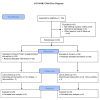Associations between Changes in Fat-Free Mass, Fecal Microbe Diversity, and Mood Disturbance in Young Adults after 10-Weeks of Resistance Training
- PMID: 36557597
- PMCID: PMC9785032
- DOI: 10.3390/microorganisms10122344
Associations between Changes in Fat-Free Mass, Fecal Microbe Diversity, and Mood Disturbance in Young Adults after 10-Weeks of Resistance Training
Abstract
Background: The gut microbiome contributes to numerous physiological processes in humans, and diet and exercise are known to alter both microbial composition and mood. We sought to explore the effect of a 10-week resistance training (RT) regimen with or without peanut protein supplementation (PPS) in untrained young adults on fecal microbiota and mood disturbance (MD).
Methods: Participants were randomized into PPS (n = 25) and control (CTL [no supplement]; n = 24) groups and engaged in supervised, full-body RT twice a week. Measures included body composition, fecal microbe relative abundance, alpha- and beta-diversity from 16 s rRNA gene sequencing with QIIME2 processing, dietary intake at baseline and following the 10-week intervention, and post-intervention MD via the profile of mood states (POMS) questionnaire. Independent samples t-tests were used to determine differences between PPS and CTL groups. Paired samples t-tests investigated differences within groups.
Results: Our sample was mostly female (69.4%), white (87.8%), normal weight (body mass index 24.6 ± 4.2 kg/m2), and 21 ± 2.0 years old. Shannon index significantly increased from baseline in all participants (p = 0.040), with no between-group differences or pre-post beta-diversity dissimilarities. Changes in Blautia abundance were associated with the positive POMS subscales, Vigor and self-esteem-related-affect (SERA) (rho = -0.451, p = 0.04; rho = -0.487, p = 0.025, respectively). Whole tree phylogeny changes were negatively correlated with SERA and Vigor (rho = -0.475, p = 0.046; rho = -0.582, p = 0.011, respectively) as well as change in bodyfat percentage (rho = -0.608, p = 0.007). Mediation analysis results indicate changes in PD Whole Tree Phylogeny was not a significant mediator of the relationship between change in fat-free mass and total MD.
Conclusions: Mood state subscales are associated with changes in microbial taxa and body composition. PD Whole Tree Phylogeny increased following the 10-week RT regimen; further research is warranted to explore how RT-induced changes in microbial diversity are related to changes in body composition and mood disturbance.
Keywords: alpha diversity; gut microbiome; profile of mood states; resistance training.
Conflict of interest statement
The authors declare no conflict of interest.
Figures


Similar articles
-
Mood disturbance, but not overall diet quality, is associated with fecal microbiome diversity in free-living adults.Nutr Neurosci. 2024 May;27(5):451-459. doi: 10.1080/1028415X.2023.2213484. Epub 2023 May 15. Nutr Neurosci. 2024. PMID: 37183583
-
Fecal Microbiota and Associated Metabolites Are Minimally Affected by Ten Weeks of Resistance Training in Younger and Older Adults.Sports (Basel). 2025 Mar 26;13(4):98. doi: 10.3390/sports13040098. Sports (Basel). 2025. PMID: 40278724 Free PMC article.
-
Associations between Diet, the Gut Microbiome, and Short-Chain Fatty Acid Production among Older Caribbean Latino Adults.J Acad Nutr Diet. 2020 Dec;120(12):2047-2060.e6. doi: 10.1016/j.jand.2020.04.018. Epub 2020 Aug 12. J Acad Nutr Diet. 2020. PMID: 32798072
-
Gut microbiota predicts body fat change following a low-energy diet: a PREVIEW intervention study.Genome Med. 2022 May 23;14(1):54. doi: 10.1186/s13073-022-01053-7. Genome Med. 2022. PMID: 35599315 Free PMC article. Clinical Trial.
-
Short-term high-intensity interval training exercise does not affect gut bacterial community diversity or composition of lean and overweight men.Exp Physiol. 2020 Aug;105(8):1268-1279. doi: 10.1113/EP088744. Epub 2020 Jun 17. Exp Physiol. 2020. PMID: 32478429
Cited by
-
"Beneficial Microbes: Food, Mood and Beyond"-Editorial and the Perspectives of Research.Microorganisms. 2023 Apr 13;11(4):1014. doi: 10.3390/microorganisms11041014. Microorganisms. 2023. PMID: 37110437 Free PMC article.
-
Growing old together: What we know about the influence of diet and exercise on the aging host's gut microbiome.Front Sports Act Living. 2023 Apr 17;5:1168731. doi: 10.3389/fspor.2023.1168731. eCollection 2023. Front Sports Act Living. 2023. PMID: 37139301 Free PMC article. Review.
-
Effects of Exercise on Gut Microbiota of Adults: A Systematic Review and Meta-Analysis.Nutrients. 2024 Apr 5;16(7):1070. doi: 10.3390/nu16071070. Nutrients. 2024. PMID: 38613103 Free PMC article.
-
Dietary Patterns, Gut Microbiota and Sports Performance in Athletes: A Narrative Review.Nutrients. 2024 May 26;16(11):1634. doi: 10.3390/nu16111634. Nutrients. 2024. PMID: 38892567 Free PMC article. Review.
References
-
- Evans C.C., LePard K.J., Kwak J.W., Stancukas M.C., Laskowski S., Dougherty J., Moulton L., Glawe A., Wang Y., Leone V., et al. Exercise prevents weight gain and alters the gut microbiota in a mouse model of high fat diet-induced obesity. PLoS ONE. 2014;9:e92193. doi: 10.1371/journal.pone.0092193. - DOI - PMC - PubMed
Grants and funding
LinkOut - more resources
Full Text Sources

